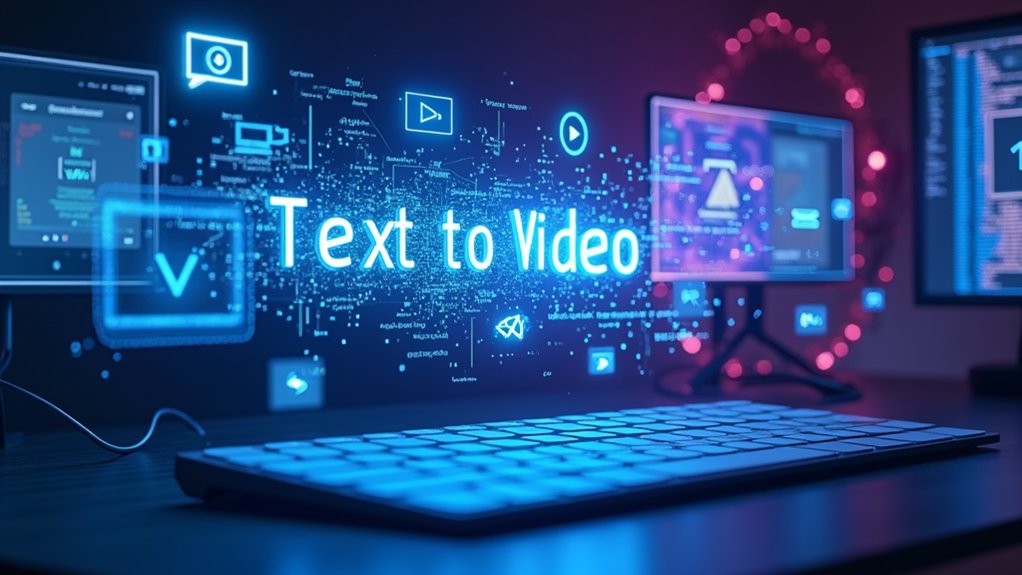Can AI Convert Text to Video?
Yes, AI can convert text to video using advanced natural language processing and image generation technologies. Modern platforms like Synthesia, Deepbrain AI, and Sora AI interpret written content to construct scenes, generate visuals, and produce voiceovers. These tools support realistic avatars, multilingual capabilities, and dynamic visual elements for marketing, education, and corporate presentations. While free options exist, premium services offer enhanced quality and features, though challenges remain in handling complex inputs and content moderation. Further exploration reveals a rapidly evolving ecosystem of text-to-video solutions.

Transforming written content into dynamic visual media has become increasingly accessible through artificial intelligence tools that convert text to video. Industry leaders including Synthesia, Deepbrain AI, and Sora AI have established sophisticated platforms that specialize in avatar-based content generation, while free alternatives like PowerDirector, MyEdit, and Animoto provide basic functionality for those with limited budgets.
These technologies employ a complex workflow that begins with natural language processing to interpret textual inputs, followed by scene construction, image generation, voice synthesis, and post-processing refinements. Similar to tools like DALL-E 3, these systems transform abstract concepts into compelling visual outputs.
From text parsing to final polish, AI-powered content creation follows a sophisticated pipeline of computational transformations.
The capabilities of text-to-video AI extend beyond simple animations, incorporating realistic avatars with customizable appearances and expressions, multilingual support for global audiences, and dynamic content elements including shifts, backgrounds, and stickers. Most platforms incorporate text-to-speech functionality while allowing users to manipulate visual assets through built-in editing tools. Tools like Synthesia offer numerous language options for voiceovers, making content accessible to diverse global audiences. AI Studio by Deepbrain AI creates videos with lifelike AI avatars that deliver text in a natural manner, enhancing viewer engagement.
This technological merging enables applications across diverse sectors, from marketing materials and educational tutorials to entertainment productions and corporate presentations.
Despite their versatility, these tools face significant technical constraints. Input complexity limitations can cause generation failures with overly detailed prompts, while output quality varies substantially between free and premium options. Content moderation issues emerge when processing potentially inappropriate or copyrighted material, and commercial usage often requires substantial investment, with platforms like Synthesia charging between $30-100 monthly.
Processing delays during bulk generation represent another challenge for users of free tiers.
The future development trajectory of text-to-video AI appears focused on enhanced visual fidelity, with 1080p/4K support becoming standard by late 2025. Emerging platforms such as Heygen prioritize photorealistic outputs from concise prompts, while Videopoet combines textual and visual inputs for context-aware creation.
Runway Gen-2 emphasizes advanced editing capabilities, and amalgamation with GPT-4 models improves contextual understanding during text processing. As these technologies mature, industry analysts anticipate greater customization options including user-defined avatars and branded asset libraries, alongside improved cross-platform merging with social media and content management systems.
Frequently Asked Questions
How Much Does AI Text-To-Video Generation Typically Cost?
AI text-to-video generation costs vary across different pricing models.
Subscription services range from $19-$96/month, with platforms like Sora (ChatGPT Plus) offering 50 priority generations at $20/month.
Credit-based systems charge approximately $6.40/minute for generative content. Costs increase with longer durations, higher resolutions, and complex scene requirements.
Free tiers typically limit users to 3 videos monthly with restricted features, while premium plans enable advanced customization capabilities and higher output quality.
What Hardware Requirements Are Needed for Text-To-Video AI Tools?
Text-to-video AI tools require robust hardware configurations for peak performance.
NVIDIA RTX 30/40 series GPUs with 16GB+ VRAM are preferred, though 6GB is the minimum requirement.
CPU recommendations include Intel Main i9 or AMD Ryzen 9 processors.
RAM should be at least 16GB, preferably 32GB or higher (twice the GPU’s VRAM).
Storage necessitates 500GB+ SSD with PCIe 4.0/5.0 interfaces for efficient data transfer.
Advanced cooling systems are essential for sustained operation.
Can Ai-Generated Videos Be Used for Commercial Purposes?
AI-generated videos can indeed be used for commercial purposes, subject to specific licensing arrangements.
Enterprise plans from platforms like Synthesia and Heygen typically include commercial rights, while free versions often require watermarks or attribution.
Users must verify they own intellectual property rights for any content reproduced.
Commercial applications also benefit from premium features like 4K resolution, branding collaboration, and API access for scaling video production across marketing campaigns.
How Does AI Handle Different Languages in Text-To-Video Conversion?
AI handles multilingual text-to-video conversion through sophisticated language processing systems that support 140+ languages.
The technology employs voice synthesis with 2,000+ AI voices across 80+ languages, automatically generates subtitles in 39+ languages, and applies AI-driven lip-sync to align mouth movements with translated dialogue.
Visual and cultural localization features adjust for regional contexts, while maintaining background continuity and adapting pacing to accommodate language-specific speech duration patterns.
What Are the Copyright Implications of Ai-Generated Videos?
AI-generated videos present complex copyright consequences.
Fully machine-created content lacks copyright protection, since U.S. and EU jurisdictions require human authorship.
Mere text prompts to AI tools remain insufficient for establishing rights. Instead, copyright eligibility depends on substantial human creative contribution, like artistic arrangement, editing, or incorporation into larger works.
Businesses using AI-generated videos commercially must conduct due diligence regarding human contribution ratios and consider potential licensing restrictions.